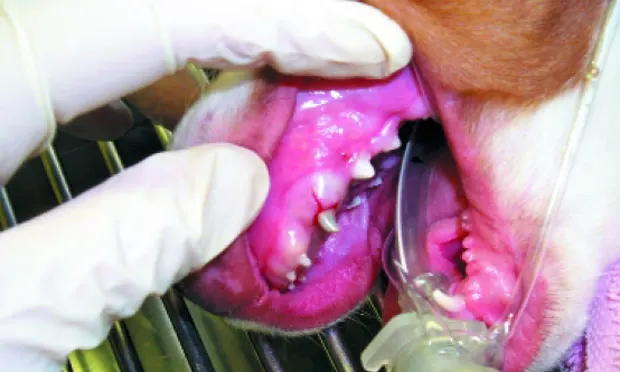To Extract or Not to Extract

A 4-month-old male Labrador retriever puppy presented for an examination and vaccinations. During the examination, a fractured right upper deciduous canine tooth was found.
History
Three days before examination, the puppy yelped during a game of "tug of war" with a string chew toy. The puppy immediately resumed play, showing no indication of discomfort, and the owner did not think about the incident again. The puppy's diet consisted of a high-quality commercial kibble, which the owner reported was being eaten with enthusiasm.
Examination
Physical examination was normal aside from a fractured upper right deciduous canine tooth (104), an open root canal, and bleeding pulp. There was no gingival swelling or other visible signs of dental pathology.
Laboratory Results
Within normal limits.
Ask yourself ...Which of the following is the optimal therapeutic plan for this dog?A. Treat with antibiotics for 14 days to prevent infection.B. Do nothing. The puppy will loose the deciduous tooth in 8 to 10 weeks.C. Extract the fractured deciduous canine tooth as soon as possible and treat with antibiotics.D. Begin feeding moist food and stop playing with the puppy to prevent further damage to the tooth.

Correct Answer: CExtract the fractured deciduous canine tooth as soon as possible and treat with antibiotics.
In this case, the owners elected to waive any therapy the day of examination. Twenty-eight days later, the pup was brought in for vaccinations and on reexamination was found to have an open and draining tract. The tract was located along the gingiva just above the first deciduous premolar, suggesting a periapical abscess of the fractured tooth. Radiographs confirmed this finding. At this visit, the owners chose to have the fractured tooth removed immediately.
Fractured deciduous teeth should be taken as seriously as fractured adult teeth, as both are a source of infection if not treated. Do not be misguided by the logic of "deciduous teeth will come out soon, so no treatment is needed."
Migrating Bacteria
Bacteria migrating into an open root canal can cause periapical abscess. Bacteria may not only create a deciduous tooth abscess, they may also invade the developing adult tooth bud. If this occurs, the adult tooth may erupt with permanent damage, such as an enamel defect, malpositioning, or an infection requiring extraction. In addition, bacteria from the abscessed tooth can enter the systemic circulation.
The most common deciduous teeth fractures occur in the canines due to the play habits of puppies. We and others believe any fractured deciduous tooth should be extracted as soon as possible. (For the dental specialist, conservative treatment may be an option: systemic antibiotic therapy and application of calcium hydroxide into the coronal cavity after removing some coronal tissue; then waiting for the tooth to exfoliate.)
Please Note. During extraction extreme care should be taken to preclude damage to the erupting permanent tooth. Be patient in breaking down the periodontal ligaments to allow for atraumatic and gentle extraction. The tip of an elevator can easily cause damage to the enamel of the permanent tooth. The puppy should be given antibiotics, such as amoxicillin/clavulanic acid (Clavamox, Pfizer, NY) or clindamycin hydrochloride (Antirobe, Pfizer, NY) after the procedure. Do not use tetracycline antibiotics, as they cause enamel discoloration in the developing adult teeth. A short course of nonsteroidal antiinflammatory drugs (NSAIDs) is also indicated for postprocedure pain management; if NSAIDs are contraindicated, buprenorphine can be used for pain.
This puppy fortunately had eruption of a normal adult canine tooth.
TX at a glance
Any fractured deciduous tooth should be extracted as soon as possible.
Provide antibiotics other than tetracyclines after the procedure.
Administer a short course of NSAIDs to manage postprocedural pain.
How to Extract the Deciduous Upper Canine Tooth
Institute a bupivacaine (Marcaine -Abbott Laboratories, North Chicago, IL) block at the mental foramen 5 to 8 minutes prior to incision. Incise over the fractured tooth with a #11 blade. Introduce a small root tip pick (elevator) into the gingival sulcus on the buccal aspect of the tooth and gently expand the tissue. Gradually work the tip to the length of the root, working on the caudal aspect only. Do not introduce the pick on the mesial aspect, where the permanent tooth bud lies. Allow time for alveolar bleeding to fatigue the ligamentous attachments. Use an ever-widening arc to expand the extraction site and help break down more attachments.
Check the tooth for looseness using "finger force." In my experience, dental extraction forceps tend to compress deciduous teeth and, as the tooth wall is very thin, may cause them to fracture. If the tooth is fairly large, a Wigg's #1 dental elevator may be used at this point for elevation.
Use controlled force when working with any extraction. If the tooth breaks and the root is abscessed, as in this case, it is necessary to incise the soft tissue and locate and remove the diseased portion of the root.
Apply topical bupivacaine (Marcaine) to the extraction site for local pain relief. Close the extraction site with 5-0 or 6-0 absorbable suture.